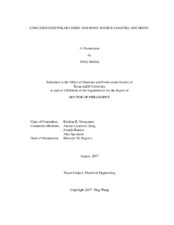| dc.contributor.advisor | Narayanan, Krishna R. | |
| dc.creator | Wang, Ying | |
| dc.date.accessioned | 2018-02-05T21:20:59Z | |
| dc.date.available | 2018-02-05T21:20:59Z | |
| dc.date.created | 2017-08 | |
| dc.date.issued | 2017-07-18 | |
| dc.date.submitted | August 2017 | |
| dc.identifier.uri | https://hdl.handle.net/1969.1/166030 | |
| dc.description.abstract | In this dissertation, we mainly address two issues: 1. improving the finite-length performance of capacity-achieving polar codes; 2. use polar codes to efficiently exploit the source redundancy to improve the reliability of the data storage system.
In the first part of the dissertation, we propose interleaved concatenation schemes of polar codes with outer binary BCH and convolutional codes to improve the finite-length performance of polar codes. For asymptotically long blocklength, we show that our schemes achieve exponential error decay rate which is much larger than the sub-exponential decay rate of standalone polar codes. In practice we show by simulation that our schemes outperform stand-alone polar codes decoded with successive cancellation or belief propagation decoding. The performance of concatenated polar and convolutional codes can be comparable to stand-alone polar codes with list decoding in the high signal to noise ratio regime. In addition to this, we show that the proposed concatenation schemes require lower memory and decoding complexity in comparison to belief propagation and list decoding of polar codes. With the proposed schemes, polar codes are able to strike a good balance between performance, memory and decoding complexity.
The second part of the dissertation is devoted to improving the decoding performance of polar codes where there is leftover redundancy after source compression. We focus on language-based sources, and propose a joint-source channel decoding scheme for polar codes. We show that if the language decoder is modeled as erasure correcting outer block codes, the rate of inner polar codes can be improved while still guaranteeing a vanishing probability of error. The improved rate depends on the frozen bit distribution of polar codes and we provide a formal proof for the convergence of that distribution. Both lower bound and maximum improved rate analysis are provided. To compare with the non-iterative joint list decoding scheme for polar codes, we study a joint iterative decoding scheme with graph codes. In particular, irregular repeat accumulate codes are exploited because of low encoding/decoding complexity and capacity achieving property for the binary erasure channel. We propose how to design optimal irregular repeat accumulate codes with different models of language decoder. We show that our scheme achieves improved decoding thresholds. A comparison of joint polar decoding and joint irregular repeat accumulate decoding is given. | en |
| dc.format.mimetype | application/pdf | |
| dc.language.iso | en | |
| dc.subject | Polar codes | en |
| dc.subject | finite length | en |
| dc.subject | concatenation | en |
| dc.subject | error decay rate | en |
| dc.subject | source redundancy | en |
| dc.subject | joint source-channel decoding | en |
| dc.subject | frozen bit distribution | en |
| dc.subject | improved rate | en |
| dc.title | Concatenated Polar Codes and Joint Source-Channel Decoding | en |
| dc.type | Thesis | en |
| thesis.degree.department | Electrical and Computer Engineering | en |
| thesis.degree.discipline | Electrical Engineering | en |
| thesis.degree.grantor | Texas A & M University | en |
| thesis.degree.name | Doctor of Philosophy | en |
| thesis.degree.level | Doctoral | en |
| dc.contributor.committeeMember | Jiang, Anxiao (Andrew) | |
| dc.contributor.committeeMember | Boutros, Joseph | |
| dc.contributor.committeeMember | Sprintson, Alex | |
| dc.type.material | text | en |
| dc.date.updated | 2018-02-05T21:21:00Z | |
| local.etdauthor.orcid | 0000-0002-9919-5236 | |


